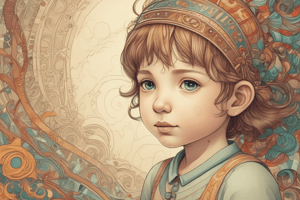Podcast
Questions and Answers
What is the primary focus of Jean Piaget's theory of cognitive development?
What is the primary focus of Jean Piaget's theory of cognitive development?
- Moral development stages
- Psychoanalytical perspectives
- Sociocultural influences
- Children's cognitive growth (correct)
How do children adjust their schemata when learning new information?
How do children adjust their schemata when learning new information?
- They assimilate or accommodate the new information. (correct)
- They discard their previous knowledge.
- They ignore the new information.
- They apply adult reasoning.
What is assimilation in the context of Piaget's cognitive development theory?
What is assimilation in the context of Piaget's cognitive development theory?
- Applying new experiences to existing schemata (correct)
- Changing schemata to incorporate new information
- Rejecting all new information
- Creating entirely new schemata from scratch
What happens during the accommodation process, according to Piaget?
What happens during the accommodation process, according to Piaget?
Which of the following best describes schemata, as outlined by Piaget?
Which of the following best describes schemata, as outlined by Piaget?
What distinguishes the discontinuity approach to development that Piaget advocates?
What distinguishes the discontinuity approach to development that Piaget advocates?
What misconception might children have based on their early schemata, as illustrated by Abdul's story?
What misconception might children have based on their early schemata, as illustrated by Abdul's story?
Which cognitive process describes the understanding of multiple concepts under one schema?
Which cognitive process describes the understanding of multiple concepts under one schema?
What does Abdul do when he learns that the animal he sees is a sheep and not a dog?
What does Abdul do when he learns that the animal he sees is a sheep and not a dog?
Which stage of Piaget's cognitive development is characterized by the understanding of object permanence?
Which stage of Piaget's cognitive development is characterized by the understanding of object permanence?
At what age range does the concrete operational stage occur according to Piaget?
At what age range does the concrete operational stage occur according to Piaget?
Which of the following is a characteristic of the formal operational stage?
Which of the following is a characteristic of the formal operational stage?
What developmental issue is associated with the sensorimotor stage?
What developmental issue is associated with the sensorimotor stage?
Which activity demonstrates learning in the sensorimotor stage?
Which activity demonstrates learning in the sensorimotor stage?
During which stage do children begin to use words and images to represent things?
During which stage do children begin to use words and images to represent things?
Which developmental issue is specifically linked to the preoperational stage?
Which developmental issue is specifically linked to the preoperational stage?
What term refers to the focused pleasure-seeking urges in Freud’s stages of development?
What term refers to the focused pleasure-seeking urges in Freud’s stages of development?
Which of the following concepts is central to Erik Erikson's psychosocial theory?
Which of the following concepts is central to Erik Erikson's psychosocial theory?
How many stages of development did Erikson propose in his psychosocial theory?
How many stages of development did Erikson propose in his psychosocial theory?
What is the primary psychosocial task during the infancy stage according to Erikson?
What is the primary psychosocial task during the infancy stage according to Erikson?
What happens if a task in Erikson's theory is not mastered?
What happens if a task in Erikson's theory is not mastered?
In which stage does Erikson believe that personality development occurs throughout the lifespan?
In which stage does Erikson believe that personality development occurs throughout the lifespan?
Which statement accurately reflects Freud's view of childhood in personality development?
Which statement accurately reflects Freud's view of childhood in personality development?
What is a key criticism of Freud's psychosexual stages according to modern psychology?
What is a key criticism of Freud's psychosexual stages according to modern psychology?
At what age do children typically start to use pronouns in their speech?
At what age do children typically start to use pronouns in their speech?
Which cognitive milestone is typically reached by the age of 4?
Which cognitive milestone is typically reached by the age of 4?
What ability is associated with a 2-year-old child?
What ability is associated with a 2-year-old child?
Which physical milestone is typically observed in children at age 5?
Which physical milestone is typically observed in children at age 5?
What is a typical social behavior for 3-year-old children?
What is a typical social behavior for 3-year-old children?
At what age do children generally begin to distinguish between real and pretend?
At what age do children generally begin to distinguish between real and pretend?
Which language ability is expected at age 4?
Which language ability is expected at age 4?
What cognitive skill is commonly developed by the age of 2?
What cognitive skill is commonly developed by the age of 2?
What is the significance of prenatal care during pregnancy?
What is the significance of prenatal care during pregnancy?
What role does the placenta play during pregnancy?
What role does the placenta play during pregnancy?
What is a teratogen?
What is a teratogen?
Why is alcohol consumption during pregnancy particularly dangerous?
Why is alcohol consumption during pregnancy particularly dangerous?
What advice might healthcare providers give to someone planning to become pregnant?
What advice might healthcare providers give to someone planning to become pregnant?
Which statement about prenatal influences is correct?
Which statement about prenatal influences is correct?
What could result from a pregnant person consuming harmful substances?
What could result from a pregnant person consuming harmful substances?
What should individuals trying to conceive consider regarding their health?
What should individuals trying to conceive consider regarding their health?
At what age do children typically begin to say their first word for meaning?
At what age do children typically begin to say their first word for meaning?
What is the primary feature of cooing in babies?
What is the primary feature of cooing in babies?
What does the 'vocabulary spurt' refer to?
What does the 'vocabulary spurt' refer to?
What does recent research suggest about the vocabulary spurt?
What does recent research suggest about the vocabulary spurt?
What ability do babies demonstrate before they start speaking?
What ability do babies demonstrate before they start speaking?
At approximately what age do children start combining words for meaning?
At approximately what age do children start combining words for meaning?
Which of the following is a characteristic of babbling in infants?
Which of the following is a characteristic of babbling in infants?
What do children generally recognize at birth regarding language?
What do children generally recognize at birth regarding language?
Flashcards
Freud's Psychosexual Stages
Freud's Psychosexual Stages
Freud proposed that a child's pleasure-seeking urges focus on different parts of the body, known as erogenous zones, during each stage of development. These stages are: oral, anal, phallic, latency, and genital.
Erikson's Psychosocial Theory
Erikson's Psychosocial Theory
Erikson modified Freud's theory to focus on social interactions and their impact on personality development, emphasizing the social nature of development rather than the sexual nature.
Lifespan Development
Lifespan Development
Erikson believed that personality development occurs throughout a person's entire life, unlike Freud who focused mainly on childhood.
Ego Identity in Psychosocial Theory
Ego Identity in Psychosocial Theory
Signup and view all the flashcards
Psychosocial Tasks
Psychosocial Tasks
Signup and view all the flashcards
Motivation for Competence
Motivation for Competence
Signup and view all the flashcards
Trust vs. Mistrust
Trust vs. Mistrust
Signup and view all the flashcards
Successful Development in Psychosocial Theory
Successful Development in Psychosocial Theory
Signup and view all the flashcards
Piaget's Cognitive Development Theory
Piaget's Cognitive Development Theory
Signup and view all the flashcards
Assimilation
Assimilation
Signup and view all the flashcards
Accommodation
Accommodation
Signup and view all the flashcards
Schemata
Schemata
Signup and view all the flashcards
How do children learn new information?
How do children learn new information?
Signup and view all the flashcards
Assimilation Example
Assimilation Example
Signup and view all the flashcards
Accommodation Example
Accommodation Example
Signup and view all the flashcards
Discontinuous Development
Discontinuous Development
Signup and view all the flashcards
Schema Accommodation
Schema Accommodation
Signup and view all the flashcards
Sensorimotor Stage
Sensorimotor Stage
Signup and view all the flashcards
Object Permanence
Object Permanence
Signup and view all the flashcards
Preoperational Stage
Preoperational Stage
Signup and view all the flashcards
Conservation
Conservation
Signup and view all the flashcards
Concrete Operational Stage
Concrete Operational Stage
Signup and view all the flashcards
Formal Operational Stage
Formal Operational Stage
Signup and view all the flashcards
Teratogen
Teratogen
Signup and view all the flashcards
Placenta
Placenta
Signup and view all the flashcards
Prenatal care
Prenatal care
Signup and view all the flashcards
Prenatal development
Prenatal development
Signup and view all the flashcards
Zygote
Zygote
Signup and view all the flashcards
Embryonic stage
Embryonic stage
Signup and view all the flashcards
Fetal stage
Fetal stage
Signup and view all the flashcards
Germinal stage
Germinal stage
Signup and view all the flashcards
Cognitive Development
Cognitive Development
Signup and view all the flashcards
Rapid Cognitive Development
Rapid Cognitive Development
Signup and view all the flashcards
Playing Make-Believe
Playing Make-Believe
Signup and view all the flashcards
Learning New Information
Learning New Information
Signup and view all the flashcards
Sorting and Categorizing
Sorting and Categorizing
Signup and view all the flashcards
Following Instructions
Following Instructions
Signup and view all the flashcards
Real vs. Pretend
Real vs. Pretend
Signup and view all the flashcards
Learning to Write
Learning to Write
Signup and view all the flashcards
Understanding Rules in Games
Understanding Rules in Games
Signup and view all the flashcards
Language Acquisition Order
Language Acquisition Order
Signup and view all the flashcards
Biological Predisposition for Language
Biological Predisposition for Language
Signup and view all the flashcards
Cooing
Cooing
Signup and view all the flashcards
Babbling
Babbling
Signup and view all the flashcards
First Word
First Word
Signup and view all the flashcards
Word Combination
Word Combination
Signup and view all the flashcards
Vocabulary Spurt
Vocabulary Spurt
Signup and view all the flashcards
Study Notes
Developmental Psychology
- Developmental psychologists study how humans change and grow throughout life
- This includes childhood, adolescence, adulthood, and death
- Development is viewed as a lifelong process
- It is studied across three domains: physical, cognitive, and psychosocial development
Physical Development
- Involves changes in the body and brain
- Includes senses, motor skills, and health
- The growth and changes in the body and brain
Cognitive Development
- Involves learning, attention, memory, language, thinking, reasoning, and creativity
Psychosocial Development
- Involves emotions, personality, and social relationships
Normative Approach to Development
- Examines "normal" development
- Early 20th century psychologists studied large amounts of children of varying ages to understand typical development milestones.
- These norms were compiled to serve as average ages for reaching developmental milestones for these domains: physical, cognitive, and psychosocial.
Issues in Developmental Psychology
- There are many different theoretical approaches to understand how humans change.
- These approaches try to look at whether development is continuous or discontinuous.
- Theories also focus on the interaction of nature versus nurture.
Continuous vs. Discontinuous Development
- Continuous development view development as a gradual and cumulative process of improvement based on prior skills.
- Discontinuous development proposes that development occurs in distinct stages.
One or Many Courses of Development?
- There is some evidence for both viewpoints.
- One course of development suggests a universal course similar across children.
- The many courses of development view highlights the uniqueness of individuals influenced by specific genetic and environmental factors.
Nature vs. Nurture
- Nature refers to biology and genetics
- Nurture refers to the environment and culture
- Both nature and nurture influence development, and they interact and influence each other in a reciprocal way
- Specific examples show how cultures can influence particular developmental outcomes.
Psychosexual Theory of Development
- Sigmund Freud proposed that personality develops in different stages in the early childhood period.
- Freud viewed development as a discontinuous process.
- The stages focus on pleasure-seeking behavior.
Psychosocial Theory of Development
- Erik Erikson proposed a psychosocial theory of development focusing on eight stages stretching across the lifespan.
- Erikson viewed development as a continuous process, where each stage has a unique psychosocial task that needs to be master to feel competent
- These psychosocial tasks include trust vs. mistrust, autonomy vs. shame and doubt, initiative vs. guilt, industry vs. inferiority, identity vs. role confusion, intimacy vs. isolation, generativity vs. stagnation, and integrity vs. despair.
Prenatal Development
- The stages are germinal (weeks 1-2), embryonic (weeks 3-8), and fetal (weeks 9-40).
- The placenta is a critical structure for supplying nourishment and oxygen.
Teratogens
- Teratogens are any agents, chemical, biological, or physical, that can cause damage to the developing embryo or fetus.
- Examples include alcohol, tobacco, and many prescription drugs.
Cognitive Theory of Development
- Jean Piaget proposed a cognitive theory of development focusing on stages.
- He theorized that children develop schemata, or mental models, by assimilating new information into existing schemes or accommodating existing schemes to fit new information
- The stages of cognitive development include sensorimotor, preoperational, concrete operational, and formal operational.
Moral Theory of Development
- Kohlberg's theory argues for multiple stages of moral reasoning in development.
Infancy Through Childhood
- Newborn reflexes are inborn automatic responses to stimulation.
- Newborn babies show preferences for specific stimuli, such as their mothers' voices and faces.
Physical Development
- Physical development is rapid during infancy, toddlerhood, and childhood.
- Growth rates vary.
- There are expected milestones of physical development for example, sitting and walking as children mature.
Adolescence
- Puberty marks the beginning of adolescence.
- This period brings a wide range of physical changes and hormonal changes.
- Cognitive development continues; adolescents' capacity for abstract thought and reasoning develops.
Emerging Adulthood
- Emerging adulthood is a relatively new period of development.
- In this stage, individuals may still be exploring their identity, career, and relationships
Adulthood
- Physical decline starts and speeds up in middle-late adulthood.
- Cognitive abilities can be fairly stable throughout early adulthood and middle age, but decline in some aspects such as memory may occur in late adulthood
Death and Grief
- Death is a significant event, viewed and experienced differently in different cultures and time periods
- The process of grief can be described by five stages, which may not be always sequential or experienced by every person facing death
Studying That Suits You
Use AI to generate personalized quizzes and flashcards to suit your learning preferences.




